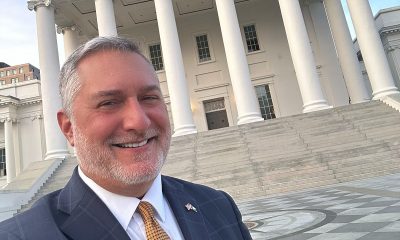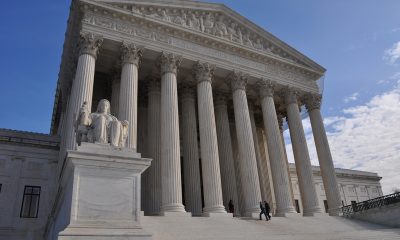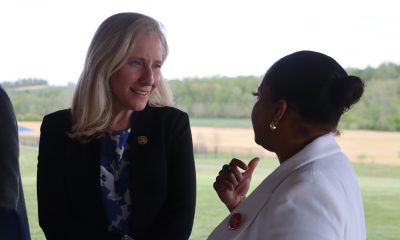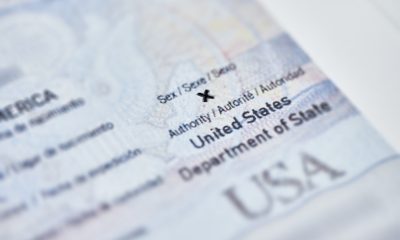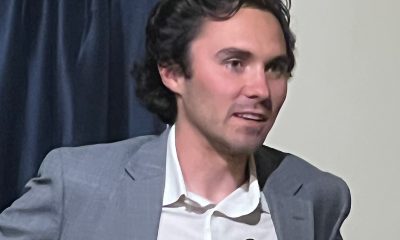National
Nat’l Coming Out Day presents unique challenges for communities of color
‘For some people, visibility equals greater danger’
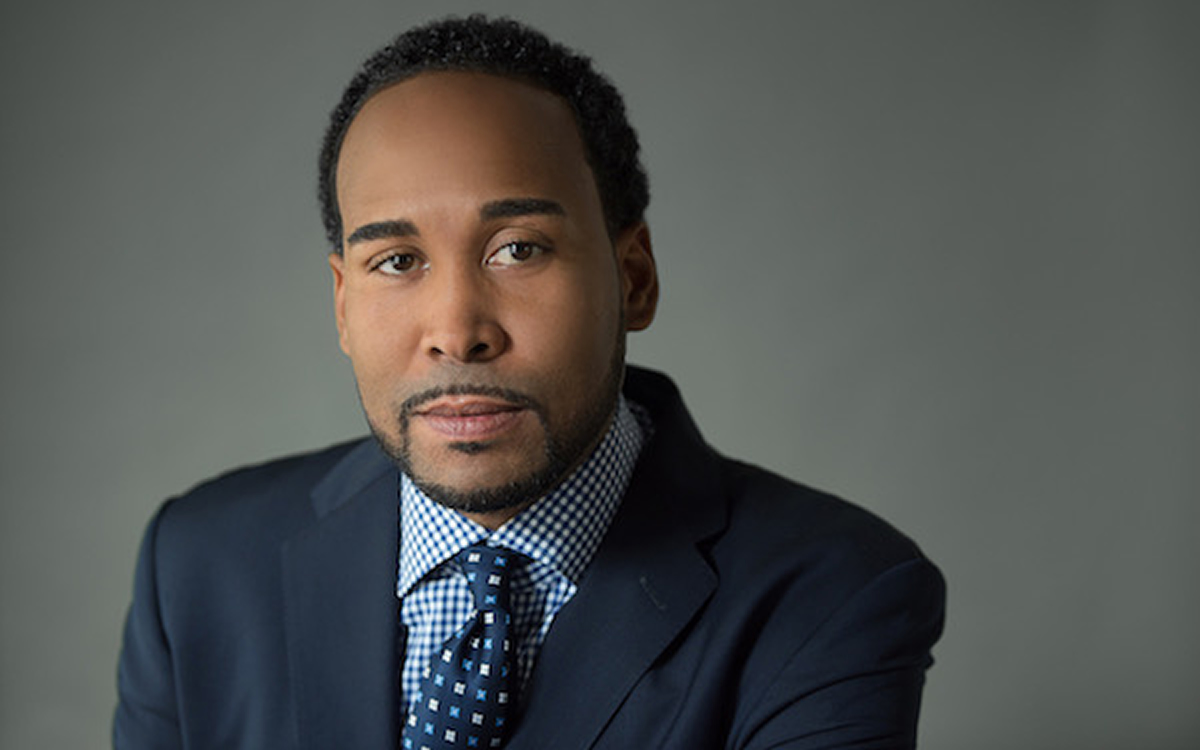
On the 34th anniversary of National Coming Out Day, LGBTQ people across the country honor the community and its fight for equality. But not everyone sees coming out as a celebration.
“Coming out is not always the best option for persons of color who already — because of our pigment on top of our identity — face discrimination, hatred and violence,” said Kimberley Bush, executive director and director of Arts and Cultural Programs at the DC Center for the LGBT Community.
The first National Coming Out Day was in 1988. Psychologist Robert Eichberg and gay rights activist Jean O’Leary, both of whom were openly queer and white, created the holiday.
In the U.S., being queer — and what that might look like — often centers whiteness. For many, the term “coming out” continues to center whiteness as the norm for LGBTQ identities.
David Johns, executive director of the National Black Justice Coalition said, “usually the narrative and the images revolve around white folks that sit down with their families and have maybe an uncomfortable conversation, but at some point they celebrate them. Those folks move to gayborhoods like Hollywood, Calif., or Chelsea, N.Y., or Boystown, Chicago. And then they get to join associations around their LGBTQ+ identities that also give them access to forms of capital and privilege that most Black folks don’t get to benefit from.”
The cultural and historical myopia inherent in the term “coming out” can minimize the complicated relationship between pride, visibility, and safety for LGBTQ people within communities of color.
“It is often challenging to be heard, seen, and just simply listened to as a LGBTQ+ person, but when you add on being a person of color, that challenge becomes much more unique and saturated. We are inherently judged, not given credibility to our own life stories and further pushed into the margins and often cannot take or retain the power in the who, when, and how we disclose our identity,” Bush said.
When talking about coming out, Johns, who identifies as same gender loving (SGL), prefers the term “inviting in.”
“The process of inviting in is a term that we use to sort of shift power and highlight the problematic nature of coming out, while also acknowledging and sometimes celebrating,” Johns said.
“Inviting in” signifies that, “no one is entitled to information about the lived experiences of other people that are not voluntarily offered up.”
And “inviting in” reallocates the individual responsibility of “coming out” and challenges the heteronormative expectation that LGBTQ or SGL people should be required to “out” themselves.
The idea of “inviting in” instead of “coming out” for communities of color also intersects with very real safety concerns for many in the community, given the current political climate, the widespread escalation of anti-LGBTQ threats online and attacks on members of the community and providers of trans-affirming healthcare across the country.
“The fact that our lives are dynamic and we face moments, sometimes daily, where we’re forced to think about inviting people in and often have to consider safety, especially now in this current political environment, is often missed,” Johns said.
For people of color living at the intersection of multiple marginalized identities, “coming out” can be even more dangerous because of heightened safety issues specific to communities of color.
“Black and brown humans have always had to fight for our freedoms,” Bush said. “Coming out can be a pressured, intense, repressive and oppressive journey that may not allow a person to feel the freedom to choose inviting in versus coming out. In addition, persons of color also exponentially experience various levels of trauma. Coming out can be an extra layer of repetitive trauma and abuse.”
In LGBTQ communities of color, interpersonal and religious violence and parental or familial responses are some of the traumas community members can face.
A Williams Institute study about parental acceptance of LGBTQ identities across different age groups found that parents gave invalidating responses to their child’s sexual identity across all age groups, and parents of children in younger age groups referred to coming out as “just a phase” or something the child was “too young to know about.”
Religion is often used to invalidate marginalized sexual and gender identities in communities of color.
Dr. Sydney Lewis, a lecturer in the Harriet Tubman Department of Women, Gender, and Sexuality Studies at the University of Maryland, College Park, attributes this negative religious response to Christianity.
“Many Christian churches have a history of being homophobic and transphobic,” Lewis said. “And I think that our reliance on Black Christianity for our community, our safety and our growth and development, has been detrimental to LGBTQ folks of color, specifically Black folks.”
Religious homophobia and transphobia complicate the coming out narrative for many queer people. Elle Moxley, a Black trans woman and founder and executive director of the Marsha P. Johnson Institute, has experienced the harms of religious homophobia and transphobia firsthand.
“I didn’t necessarily, as a Black person, feel comfortable coming out or aligning with any rhetoric around that because a lot of times people are forced out,” Moxley said. “In my experience, growing up as a child in the COGIC (Church of God in Christ) religion, there wasn’t an invitation to come out. I was forced out at 12 years old.”
While queer people have always existed, there is an intentional erasure of gay, trans, and non-binary people within Christianity that stems from colonialism.
The visibility of queer sexuality in Black culture can be traced back to the Harlem Renaissance, where literature and music were full of stories about lived queer experiences. And non-binary identities have always been visible and integrated in some communities of color like in North American Indigenous cultures and Pacific Island cultures. Terms like “fa’afafine” in Samoa and “māhū” in Hawai’i are used to signify that someone identifies as non-binary (or “third gender”).
In LGBTQ communities today, the idea that “coming out” means being more free to openly be yourself in public often elides the very real danger of visibility in trans lives of color.
“There’s this idea that visibility somehow equals greater freedom, but for some people, visibility equals greater danger,” Lewis said.
The Human Rights Campaign reports that 31 trans people have been killed so far this year, while a Williams Institute study found that transgender people are four times more likely than cisgender people to be victims of violent crime.
On a day like National Coming Out Day, which is thought to not only symbolize pride but also inclusion, people like Elle Moxley are asking not for inclusion, but equity.
“I always say that inclusion is something that happened after the fact. I don’t subscribe to that,” Moxley said. “But what I do subscribe to is that reparations are an essential part to how equity in society happens.”
People like David Johns are also calling attention to how complicated a celebration like National Coming Out Day can be for LGBTQ communities of color.
“For the Black trans woman with a disability in Jackson, Miss., or my parents’ state of Texas, given the position that those governors have them in, it probably is not safe for them to come out even on a day we’re raising awareness as a part of a goal,” Johns said.
(Editor’s note: This story is part of a new Blade Foundation initiative focusing on the intersection between race and LGBTQ identities. It is funded by a grant from the Leonard-Litz Foundation.)
Federal Government
HHS to retire 988 crisis lifeline for LGBTQ youth
Trevor Project warns the move will ‘put their lives at risk’

The U.S. Department of Health and Human Services is planning to retire the national 988 crisis lifeline for LGBTQ youth on Oct. 1, according to a preliminary budget document obtained by the Washington Post.
Introduced during the Biden-Harris administration in 2022, the hotline connects callers with counselors who are trained to work with this population, who are four times likelier to attempt suicide than their cisgender or heterosexual counterparts.
“Suicide prevention is about risk, not identity,” said Jaymes Black, CEO of the Trevor Project, which provides emergency crisis support for LGBTQ youth and has contracted with HHS to take calls routed through 988.
“Ending the 988 Suicide and Crisis Lifeline’s LGBTQ+ youth specialized services will not just strip away access from millions of LGBTQ+ kids and teens — it will put their lives at risk,” they said in a statement. “These programs were implemented to address a proven, unprecedented, and ongoing mental health crisis among our nation’s young people with strong bipartisan support in Congress and signed into law by President Trump himself.”
“I want to be clear to all LGBTQ+ young people: This news, while upsetting, is not final,” Black said. “And regardless of federal funding shifts, the Trevor Project remains available 24/7 for anyone who needs us, just as we always have.”
The service for LGBTQ youth has received 1.3 million calls, texts, or chats since its debut, with an average of 2,100 contacts per day in February.
“I worry deeply that we will see more LGBTQ young people reach a crisis state and not have anyone there to help them through that,” said Janson Wu, director of advocacy and government affairs at the Trevor Project. “I worry that LGBTQ young people will reach out to 988 and not receive a compassionate and welcoming voice on the other end — and that will only deepen their crisis.”
Under Trump’s HHS secretary, Robert F. Kennedy, Jr., the agency’s departments and divisions have experienced drastic cuts, with a planned reduction in force of 20,000 full-time employees. The Substance Abuse and Mental Health Services Administration has been sunset and mental health services consolidated into the newly formed Administration for a Healthy America.
The budget document reveals, per Mother Jones, “further sweeping cuts to HHS, including a 40 percent budget cut to the National Institutes of Health; elimination of funding for Head Start, the early childhood education program for low-income families; and a 44 percent funding cut to the Centers for Disease Control, including all the agency’s chronic disease programs.”
U.S. Supreme Court
Supreme Court hears oral arguments in LGBTQ education case
Mahmoud v. Taylor plaintiffs argue for right to opt-out of LGBTQ inclusive lessons

The U.S. Supreme Court on Tuesday heard oral arguments in Mahmoud v. Taylor, a case about whether Montgomery County, Md., public schools violated the First Amendment rights of parents by not providing them an opportunity to opt their children out of reading storybooks that were part of an LGBTQ-inclusive literacy curriculum.
The school district voted in early 2022 to allow books featuring LGBTQ characters in elementary school language arts classes. When the county announced that parents would not be able to excuse their kids from these lessons, they sued on the grounds that their freedom to exercise the teachings of their Muslim, Jewish, and Christian faiths had been infringed.
The lower federal courts declined to compel the district to temporarily provide advance notice and an opportunity to opt-out of the LGBTQ inclusive curricula, and the 4th U.S. Circuit Court of Appeals determined that the parents had not shown that exposure to the storybooks compelled them to violate their religion.
“LGBTQ+ stories matter,” Human Rights Campaign President Kelley Robinson said in a statement Tuesday. “They matter so students can see themselves and their families in the books they read — so they can know they’re not alone. And they matter for all students who need to learn about the world around them and understand that while we may all be different, we all deserve to be valued and loved.”
She added, “All students lose when we limit what they can learn, what they can read, and what their teachers can say. The Supreme Court should reject this attempt to silence our educators and ban our stories.”
GLAD Law, NCLR, Family Equality, and COLAGE submitted a 40-page amicus brief on April 9, which argued the storybooks “fit squarely” within the district’s language arts curriculum, the petitioners challenging the materials incorrectly characterized them as “specialized curriculum,” and that their request for a “mandated notice-and-opt-out requirement” threatens “to sweep far more broadly.”
Lambda Legal, the Leadership Conference on Civil and Human Rights, PFLAG, and the National Women’s Law Center announced their submission of a 31-page amicus brief in a press release on April 11.
“All students benefit from a school climate that promotes acceptance and respect,” said Karen Loewy, senior counsel and director of constitutional law practice at Lambda Legal. “Ensuring that students can see themselves in the curriculum and learn about students who are different is critical for creating a positive school environment. This is particularly crucial for LGBTQ+ students and students with LGBTQ+ family members who already face unique challenges.”
The organizations’ brief cited extensive social science research pointing to the benefits of LGBTQ-inclusive instruction like “age-appropriate storybooks featuring diverse families and identities” benefits all students regardless of their identities.
Also weighing in with amici briefs on behalf of Montgomery County Public Schools were the National Education Association, the ACLU, and the American Psychological Association.
Those writing in support of the parents challenging the district’s policy included the Center for American Liberty, the Manhattan Institute, Parents Defending Education, the Alliance Defending Freedom, the Trump-Vance administration’s U.S. Department of Justice, and a coalition of Republican members of Congress.
U.S. Supreme Court
LGBTQ groups: SCOTUS case threatens coverage of preventative services beyond PrEP
Kennedy v. Braidwood oral arguments heard Monday

Following Monday’s oral arguments before the U.S. Supreme Court in Kennedy v. Braidwood Management, Inc., LGBTQ groups issued statements warning the case could imperil coverage for a broad swath of preventative services and medications beyond PrEP, which is used to reduce the risk of transmitting HIV through sex.
Plaintiffs brought the case to challenge a requirement that insurers and group health plans cover the drug regimen, arguing that the mandate “encourage[s] homosexual behavior, intravenous drug use, and sexual activity outside of marriage between one man and one woman.”
The case has been broadened, however, such that cancer screenings, heart disease medications, medications for infants, and several other preventive care services are in jeopardy, according to a press release that GLAAD, Lambda Legal, PrEP4All, Harvard Law’s Center for Health Law and Policy Innovation (CHLPI), and the Center for HIV Law and Policy (CHLP) released on Monday.
The Trump-Vance administration has argued the independent task force responsible for recommending which preventative services must be covered with no cost-sharing for patients is constitutional because the secretary of the U.S. Department of Health and Human Services can exercise veto power and fire members of the volunteer panel of national experts in disease prevention and evidence-based medicine.
While HHS secretaries have not exercised these powers since the Affordable Care Act was passed in 2010, Braidwood could mean Trump’s health secretary, Robert F. Kennedy Jr., takes a leading role in determining which services are included in the coverage mandate.
Roll Call notes the Supreme Court case comes as the administration has suspended grants to organizations that provide care for and research HIV while the ongoing restructuring of HHS has raised questions about whether the “Ending the HIV Epidemic” begun under Trump’s first term will be continued.
“Today’s Supreme Court hearing in the Braidwood case is a pivotal moment for the health and rights of all Americans,” said GLAAD President Sarah Kate Ellis. “This case, rooted in discriminatory objections to medical necessities like PrEP, can undermine efforts to end the HIV epidemic and also jeopardize access to essential services like cancer screenings and heart disease medications, disproportionately affecting LGBTQ people and communities of color.”
She added, “Religious exemptions should not be weaponized to erode healthcare protections and restrict medically necessary, life-saving preventative healthcare for every American.”
Lambda Legal HIV Project Director Jose Abrigo said, “The Braidwood case is about whether science or politics will guide our nation’s public health policy. Allowing ideological or religious objections to override scientific consensus would set a dangerous precedent. Although this case began with an attack on PrEP coverage, a critical HIV prevention tool, it would be a serious mistake to think this only affects LGBTQ people.”
“The real target is one of the pillars of the Affordable Care Act: The preventive services protections,” Abrigo said. “That includes cancer screenings, heart disease prevention, diabetes testing, and more. If the plaintiffs succeed, the consequences will be felt across every community in this country, by anyone who relies on preventive care to stay healthy.”
He continued, “What’s at stake is whether we will uphold the promise of affordable and accessible health care for all or allow a small group of ideologues to dismantle it for everyone. We as a country are only as healthy as our neighbors and an attack on one group’s rights is an attack on all.”
PrEP4All Executive Director Jeremiah Johnson said, “We are hopeful that the justices will maintain ACA protections for PrEP and other preventive services, however, advocates are poised to fight for access no matter the outcome.”
He continued, “Implementing cost-sharing would have an enormous impact on all Americans, including LGBTQ+ individuals. Over 150 million people could suddenly find themselves having to dig deep into already strained household budgets to pay for care that they had previously received for free. Even small amounts of cost sharing lead to drops in access to preventive services.”
“For PrEP, just a $10 increase in the cost of medication doubled PrEP abandonment rates in a 2024 modeling study,” Johnson said. “Loss of PrEP access would be devastating with so much recent progress in reining in new HIV infections in the U.S. This would also be a particularly disappointing time to lose comprehensive coverage for PrEP with a once every six month injectable version set to be approved this summer.”
“Today’s oral arguments in the Braidwood case underscore what is at stake for the health and well-being of millions of Americans,” said CHLPI Clinical Fellow Anu Dairkee. “This case is not just about legal technicalities — it is about whether people across the country will continue to have access to the preventive health services they need, without cost sharing, regardless of who they are or where they come from.”
She continued, “Since the Affordable Care Act’s preventive services provision took effect in 2010, Americans have benefited from a dramatic increase in the use of services that detect disease early, promote healthy living, and reduce long-term health costs. These benefits are rooted in the work of leading scientists and public health experts, including the U.S. Preventive Services Task Force, whose recommendations are based on rigorous, peer-reviewed evidence.”
“Any shift away from cost-free access to preventive care could have wide-ranging implications, potentially limiting access for those who are already navigating economic hardship and health disparities,” Dairkee said. “If Braidwood prevails, the consequences will be felt nationwide. We risk losing access to lifesaving screenings and preventive treatments that have become standard care over the past decade.”
“This case should serve as a wake-up call: Science, not politics, must guide our health care system,” she said. “The health of our nation depends on it.”
“We are grateful for the Justices who steadfastly centered constitutionality and didn’t allow a deadly political agenda to deter them from their job at hand,” said CHLP Staff Attorney Kae Greenberg. “While we won’t know the final decision until June, what we do know now is not having access to a full range of preventative healthcare is deadly for all of us, especially those who live at the intersections of racial, gender and economic injustice.”
“We are crystal clear how the efforts to undermine the ACA, of which this is a very clear attempt, fit part and parcel into an overall agenda to rollback so much of the ways our communities access dignity and justice,” he said. “Although the plaintiffs’ arguments today were cloaked in esoteric legal language, at it’s heart, this case revolves around the Christian Right’s objection to ‘supporting’ those who they do not agree with, and is simply going to result in people dying who would otherwise have lived long lives.”
“This is why CHLP is invested and continues in advocacy with our partners, many of whom are included here,” Greenberg said.

